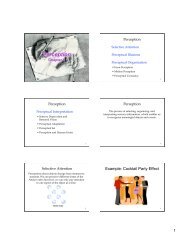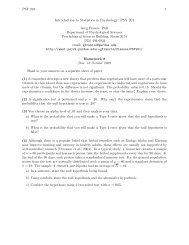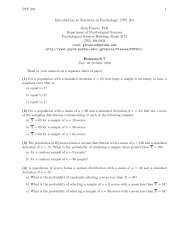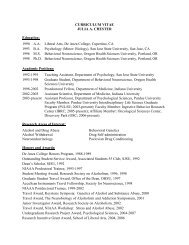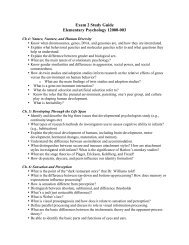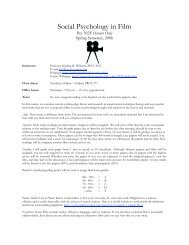Maxims or Myths of Beauty? A Meta-Analytic and Theoretical Review
Maxims or Myths of Beauty? A Meta-Analytic and Theoretical Review
Maxims or Myths of Beauty? A Meta-Analytic and Theoretical Review
You also want an ePaper? Increase the reach of your titles
YUMPU automatically turns print PDFs into web optimized ePapers that Google loves.
398 LANGLOIS ET AL.<br />
Effect Sizes<br />
Data Analyses<br />
Using DSTAT (B. T. Johnson, 1989), we first calculated one effect size<br />
f<strong>or</strong> the overall categ<strong>or</strong>y (e.g., treatment), collapsing across all subcatego-<br />
des. Because each sample <strong>of</strong> participants should contribute only one entry<br />
per analysis (Hedges & Olkin, 1985), multiple effect sizes obtained from<br />
the same participants were converted to Z sc<strong>or</strong>es, averaged, <strong>and</strong> the average<br />
converted back to an r, resulting in only one effect size per sample<br />
(Rosenthal, 1995). When this process necessitated averaging ns <strong>of</strong> slightly<br />
different sizes, usually due to participant attrition on certain measures but<br />
not others (e.g., Leinbach & Fagot, 1991), we used the smallest n to be<br />
most conservative. Most <strong>of</strong>ten, averaging was perf<strong>or</strong>med within individual<br />
studies, but on a few occasions, separate studies rep<strong>or</strong>ted statistics from the<br />
same sample (e.g., Jovanovic, Lerner, & Lerner, 1989; Lerner et al., 1990,<br />
1991), <strong>and</strong> then the rs from m<strong>or</strong>e than one study were averaged. Second,<br />
we calculated separate effect sizes f<strong>or</strong> each subcateg<strong>or</strong>y <strong>of</strong> dependent<br />
variables (e.g., social skills). At the subcateg<strong>or</strong>y level, multiple measures <strong>of</strong><br />
the same construct obtained from the same participants were averaged,<br />
again resulting in only one effect size per sample in each subcateg<strong>or</strong>y.<br />
F<strong>or</strong> the reliability analyses, most studies provided c<strong>or</strong>relational statistics<br />
that could be used directly. Because different studies rep<strong>or</strong>ted different<br />
types <strong>of</strong> reliability coefficients, we converted the different coefficients<br />
(e.g., Kendalrs tau) to an r value. We computed both mean interrater <strong>and</strong><br />
effective reliabilities (see Rosenthal, 1991, f<strong>or</strong> conversion statistics). Mean<br />
interrater reliability estimates agreement between specific pairs <strong>of</strong> judges<br />
whereas effective reliabilities estimate the reliability <strong>of</strong> the mean <strong>of</strong> the<br />
judges' ratings (Rosenthal, 1991). We, like Rosenthal, prefer effective<br />
reliabilities because we are m<strong>or</strong>e interested in generalizing to how raters in<br />
general would agree than in the agreement <strong>of</strong> single pairs <strong>of</strong> judges<br />
evaluating a single face (Rosenthal, 1991). Just as a longer test is a m<strong>or</strong>e<br />
reliable assessment <strong>of</strong> a construct than a two-item test, the effective<br />
reliability coefficient is a m<strong>or</strong>e reliable estimate <strong>of</strong> attractiveness because<br />
it accounts f<strong>or</strong> the sampling err<strong>or</strong>s in small samples (Guilf<strong>or</strong>d & Fruchter,<br />
1973; Nurmally, 1978). Although we rep<strong>or</strong>t both estimates <strong>of</strong> reliability in<br />
Table 3, we discuss the results <strong>of</strong> the analysis <strong>of</strong> effective reliabilities, <strong>and</strong><br />
we analyze moderat<strong>or</strong> variables only f<strong>or</strong> effective reliability.<br />
F<strong>or</strong> judgment, treatment, <strong>and</strong> behavi<strong>or</strong>s/traits, studies provided primarily<br />
group difference statistics from which effect size could be calculated (t, p,<br />
F, <strong>and</strong> g2). If an effect size was rep<strong>or</strong>ted only as nonsignificant (without a<br />
specific, numerical result rep<strong>or</strong>ted), it was coded as zero (Rosenthal, 1991).<br />
Because including such effect sizes may underestimate the actual effect<br />
Table 3<br />
<strong>Meta</strong>-Analyses <strong>of</strong> Reliability<br />
size whereas excluding them may overestimate it, we perf<strong>or</strong>med each<br />
categ<strong>or</strong>y <strong>and</strong> subcateg<strong>or</strong>y analysis twice, first including studies in which<br />
effect sizes were coded as zero <strong>and</strong> then excluding these same studies<br />
(Rosenthal, 1991, 1995). We calculated the Q(B) statistic to assess whether<br />
there were any differences between the data sets including <strong>or</strong> excluding<br />
nonsignificant effects coded as zero (see Hedges & Olkin, 1985).<br />
F<strong>or</strong> each analysis, several statistics are rep<strong>or</strong>ted (Rosenthal, 1991, 1995):<br />
k (number <strong>of</strong> effect sizes in the analysis), n (total number <strong>of</strong> participants in<br />
the analysis), Mdn d (median effect size), d+ (averaged weighted effect<br />
size), 95% confidence interval, fail-safe n, <strong>and</strong> BESD (binomial effect-size<br />
display). The BESD is an estimate <strong>of</strong> the practical significance <strong>of</strong> the effect<br />
size <strong>and</strong> indicates the change in success rate in the dependent variable due<br />
to attractiveness. Thus, a BESD <strong>of</strong> .5 indicates a 50% higher success rate<br />
f<strong>or</strong> attractive than unattractive people. The absolute success rate f<strong>or</strong> each<br />
group is calculated by .50 + (BESD/2) (Rosenthal, 1991). We rep<strong>or</strong>t the<br />
BESD statistic in the f<strong>or</strong>m <strong>of</strong> the two percentages reflecting, first, the<br />
prop<strong>or</strong>tion <strong>of</strong> attractive children above the mean in the categ<strong>or</strong>y <strong>and</strong>,<br />
second, the prop<strong>or</strong>tion <strong>of</strong> unattractive children above the mean (i.e., 75%<br />
vs. 25% indicates that 75% <strong>of</strong> attractive children are judged m<strong>or</strong>e fav<strong>or</strong>ably<br />
than the average child whereas only 25% <strong>of</strong> unattractive children are<br />
judged m<strong>or</strong>e fav<strong>or</strong>ably than average). Finally, we rep<strong>or</strong>t Q (heterogeneity<br />
<strong>of</strong> the effect sizes).<br />
Moderat<strong>or</strong> Variables<br />
Following the rationale <strong>and</strong> procedures <strong>of</strong> Knight, Fabes, <strong>and</strong> Higgins<br />
(1996), we assessed variance accounted f<strong>or</strong> by moderat<strong>or</strong> variables using<br />
weighted multiple regression analyses that control f<strong>or</strong> relations among<br />
moderat<strong>or</strong>s. These analyses were perf<strong>or</strong>med only f<strong>or</strong> the overall categ<strong>or</strong>ies<br />
because, in most instances, the sample sizes <strong>of</strong> the subcateg<strong>or</strong>ies were too<br />
small to allow meaningful subdivision by moderat<strong>or</strong> variables.<br />
Data Reduction <strong>and</strong> Confirmat<strong>or</strong>y Analyses<br />
Including Versus Excluding Studies With Unspecified<br />
Nonsignificant Effect Size(s)<br />
On the basis <strong>of</strong> the recommendations <strong>of</strong> Rosenthal (1995), we perf<strong>or</strong>med<br />
analyses both including <strong>and</strong> excluding studies with nonsignificant effect<br />
size(s) coded as zero. Because the Q(B) statistic (Hedges & Olkin, 1985)<br />
indicated that there were no instances in which significant differences were<br />
found between the two data sets, in the interest <strong>of</strong> brevity we rep<strong>or</strong>t<br />
Type <strong>of</strong> 95% Mdn Fail-safe<br />
Type <strong>of</strong> judgment estimate r CI r N BESD Heterogeneity (p)<br />
Adult within-culture<br />
k = 88 (67 studies) Effective .90* .89/.91 .91 36,608 .90 1,304.32 (< .001)<br />
n = 1,694 Mean .47* .43/.51 .67 9,240 .47 782.95 (< .001)<br />
Child within-culture<br />
k = 28 (20 studies) Effective .85* .83L86 .91 8,876 .85 482.23 (< .0,01)<br />
n = 1,182 Mean .'21" .16/.26 .30 1,148 .18 113.28 (< .001)<br />
Adult cross-cultural<br />
k = 17 (9 studies) Effective .94* .93L95 .99 9,503 .94 22,152.05 (< .001)<br />
n = 12,146 Mean .71" .70/.72 .69 3,434 .71 752.06 (< .001)<br />
Adult cross-ethnic<br />
k = 9 (6 studies) Effective .88* .87/.90 .99 3,411 .88 617.13 (< .001)<br />
n = 659 Mean .54* .48L59 .74 1,134 .54 238.00 (< .001)<br />
Note. k = number <strong>of</strong> independent samples; CI = confidence" interval; BESD = binomial effect-size display.<br />
* p < .05.



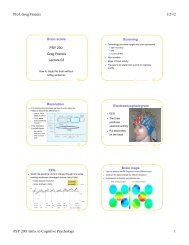

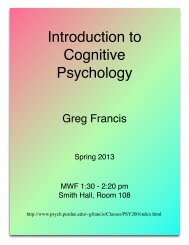
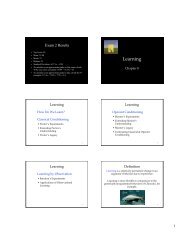
![Exam 4 Study Guide[1]](https://img.yumpu.com/45196739/1/190x245/exam-4-study-guide1.jpg?quality=85)
